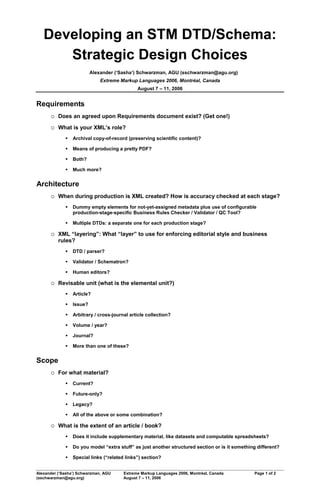Extreme-ML-2006-Poster-A-Schwarzman
- 1. Alexander (ŌĆśSashaŌĆÖ) Schwarzman, AGU Extreme Markup Languages 2006, Montr├®al, Canada Page 1 of 2 (sschwarzman@agu.org) August 7 ŌĆō 11, 2006 Developing an STM DTD/Schema: Strategic Design Choices Alexander (ŌĆśSashaŌĆÖ) Schwarzman, AGU (sschwarzman@agu.org) Extreme Markup Languages 2006, Montr├®al, Canada August 7 ŌĆō 11, 2006 Requirements ’éĪ Does an agreed upon Requirements document exist? (Get one!) ’éĪ What is your XMLŌĆÖs role? ’é¦ Archival copy-of-record (preserving scientific content)? ’é¦ Means of producing a pretty PDF? ’é¦ Both? ’é¦ Much more? Architecture ’éĪ When during production is XML created? How is accuracy checked at each stage? ’é¦ Dummy empty elements for not-yet-assigned metadata plus use of configurable production-stage-specific Business Rules Checker / Validator / QC Tool? ’é¦ Multiple DTDs: a separate one for each production stage? ’éĪ XML ŌĆ£layeringŌĆØ: What ŌĆ£layerŌĆØ to use for enforcing editorial style and business rules? ’é¦ DTD / parser? ’é¦ Validator / Schematron? ’é¦ Human editors? ’éĪ Revisable unit (what is the elemental unit?) ’é¦ Article? ’é¦ Issue? ’é¦ Arbitrary / cross-journal article collection? ’é¦ Volume / year? ’é¦ Journal? ’é¦ More than one of these? Scope ’éĪ For what material? ’é¦ Current? ’é¦ Future-only? ’é¦ Legacy? ’é¦ All of the above or some combination? ’éĪ What is the extent of an article / book? ’é¦ Does it include supplementary material, like datasets and computable spreadsheets? ’é¦ Do you model ŌĆ£extra stuffŌĆØ as just another structured section or is it something different? ’é¦ Special links (ŌĆ£related linksŌĆØ) section?
- 2. Developing an STM DTD / Schema: Strategic Design Choices (contŌĆÖd) Alexander (ŌĆśSashaŌĆÖ) Schwarzman, AGU Extreme Markup Languages 2006, Montr├®al, Canada Page 2 of 2 (sschwarzman@agu.org) August 7 ŌĆō 11, 2006 Modeling Language Choices ’éĪ Which constraint language is primary? ’é¦ DTD? ’é¦ XSD? ’é¦ RELAX NG? ’éĪ How many DTDs / schemas (purpose of each)? ’é¦ Authoring? ’é¦ Conversion / Transformation? ’é¦ Production? ’é¦ Archiving? ’éĪ Separate or shared: If your content includes journal article, newspaper article, book chapter, book, case study, lecture notes, etc., should you use: ’é¦ Distinct DTD / schema for each? ’é¦ A large shared structure? ’é¦ A DTD / schema suite with common modules? ’éĪ ŌĆ£Off-the-shelf, Altered-to-fit, or Bespoke?ŌĆØ (T. Usdin) ’é¦ If altered, what public model? ’é¦ ŌĆ£compatible withŌĆØ or ŌĆ£informed byŌĆØ (subset or superset)? ’é¦ If bespoke, do you use any public models at all (for tables and math, for instance)? Modeling Design Choices ’éĪ ŌĆ£PrussianŌĆØ or ŌĆ£CalifornianŌĆØ: prescriptive or descriptive? Flexible or enforcing? ’éĪ Generated or Explicit text? (depends on XMLŌĆÖs role) ’é¦ Preserve generation / rendition rules? ’é¦ Different approach for text and bibliographic references? ’éĪ How to model bibliographic references? ’é¦ Mixed content? ’é¦ Genre-specific ŌĆ£strict modelsŌĆØ (with an escape hatch provided)? ’é¦ ŌĆ£Tag abuseŌĆØ tolerance? ’éĪ How to reference non-XML components, e.g., figures, in XML? ’é¦ By an ID that maps to a set of multiple images in an archive? ’é¦ By naming a specific file from the set? Which one is ŌĆ£the mother of all imagesŌĆØ? ’é¦ Which components to store / migrate? Is ŌĆ£storing cheaper than thinkingŌĆØ? (D. Lapeyre) ’éĪ How to model math? ’é¦ MathML presentation versus content (computation)? ’āś How to ensure the identicalness of the same math symbols in different browsers (same UNICODE codepoints look differently in various browsers, e.g., epsilon and varepsilon)? ’é¦ LaTeX plus GIFs? ’āś How to ensure the identicalness of special characters that occur both in a displayed formula and inline? ’é¦ Just GIFs? ’éĪ ŌĆ£Just because you can, doesnŌĆÖt mean you shouldŌĆØ (D. Lapeyre) ’é¦ The lure of modeling for its own sake. Simplicity maintains better over time

